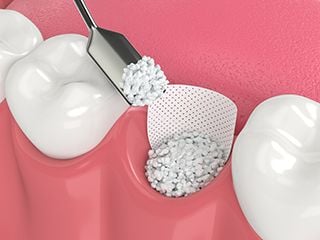The alveolar ridges are thickened ridges of bone on the upper and lower jaws. Teeth fit into sockets in these ridges, where they are held securely in place by periodontal ligaments. If the alveolar bone loses volume and density, that secure attachment is compromised. Bone grafting is a common surgical procedure which replaces and repairs damaged bone.
Bone loss in the jaw can have serious consequences for your dental health. Bone loss leads to loosening and eventual loss of teeth. Teeth shift, affecting your bite. Lack of bone density makes the placement of dental implants or implant-supported dentures impossible. Further, facial muscles and features lose structural support, causing a sunken appearance in the lips, cheeks, and chin.
Conditions that Cause Bone Loss
- Resorption
When a tooth is lost, the bone ridge under the missing tooth gradually begins to shrink, a process called resorption. Without the stimulation of biting and chewing, new bone cells aren’t produced quickly enough to replace older bone tissue.
- Periodontitis
Gum disease is progressive, and a leading cause of tooth loss. Left untreated, periodontitis causes gum recession, exposing bone and connective tissue to destructive bacteria and infection.
- Trauma
Bone damage caused by trauma might require bone replacement or recontouring.
- Bone Structure and Size
Sometimes the alveolar ridge is too narrow or shallow to support an implant, especially in the back of the upper jaw near the sinus cavity. In this case, the bone will need to be built up before an implant can be placed.
Bone Graft Procedure
 To prevent bone loss from affecting your quality of life, your dentist might recommend a bone graft. During this procedure, grafting material is implanted in the damaged area, where it serves as a platform for your own bone tissue to regenerate and restore bone volume and density.
To prevent bone loss from affecting your quality of life, your dentist might recommend a bone graft. During this procedure, grafting material is implanted in the damaged area, where it serves as a platform for your own bone tissue to regenerate and restore bone volume and density.
There are several types of grafting material, and your dentist can help you choose the type of graft which will work best for you.
- Autografts: Bone tissue taken from elsewhere in your body
- Allografts: Screened and prepared bone material provided by a human tissue bank
- Xenografts: Screened and prepared bone provided by an animal tissue bank (typically cow bone)
- Alloplastic grafts: Synthetic grafting material manufactured with biocompatible mineral compounds
- Growth factors might be applied with the grafting material to stimulate cell growth
Autografts, because they use your own living tissue, can regenerate new bone cells and are resorbed over time. Other graft materials serve as a framework for your bone tissue to build upon.
A bone graft is typically performed using local anesthesia. If you are interested in sedation, your dentist can suggest options. During the procedure, an incision is made in the gum tissue to reveal damaged or missing bone. Grafting material is placed and shaped to restore the bone’s contours. A protective membrane may be placed over the graft to stabilize it and to prevent gum tissue from growing into the graft area.
The gums will be closed with sutures. The membrane and sutures may dissolve over several days or weeks, or you may need to return to have them removed. You’ll receive detailed instructions for after care and follow-up visits. The time it takes for you to heal completely will depend in part on the size and type of your graft.
Bone grafts can restore the shape, size, and density of your jawbone, protecting you from further bone and tooth loss and providing a solid foundation for implants. Talk to your dentist to discover how bone grafting can improve your dental health and transform your smile.
